Part 3: Rise and Fall
Words and pictures: Ron Hewit
J. Hewit & Son, Blacksmiths went out of business in 1986 when Dad finally conceded that he was losing money rather than making it, a catastrophic turnaround from a few decades earlier when the business was expanding. In the early 1930s my grandad installed petrol pumps in front of the house – one pump for premium 4-star Shell, two further down the street for 2-star and a fourth for diesel. A photograph dated 1933 shows my grandad standing proudly in front of the four-star pump; another shows my dad and his sisters, Ada and Ethel, standing next to the two-star pumps. Nearer the house there was also a row of cabinets in white and in Castrol green for dispensing various types of oil and grease – everything a passing motorist could ask for.
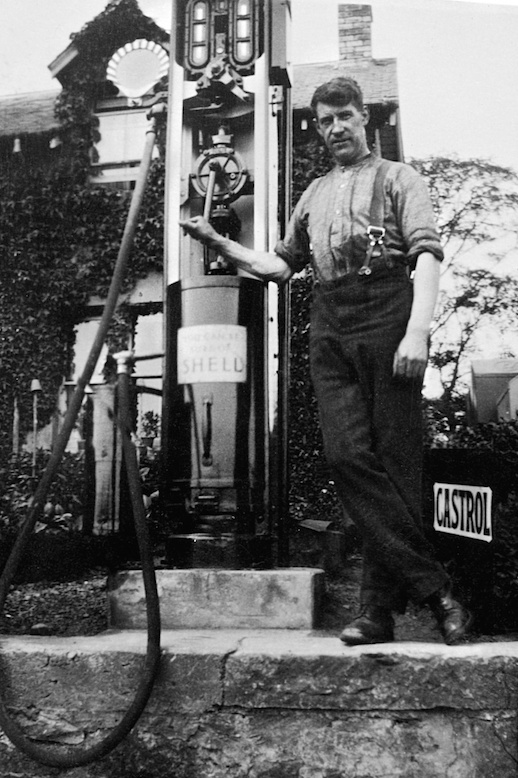
Grandad, John Hewit, poses with the petrol pump at the front of the family home, 1933
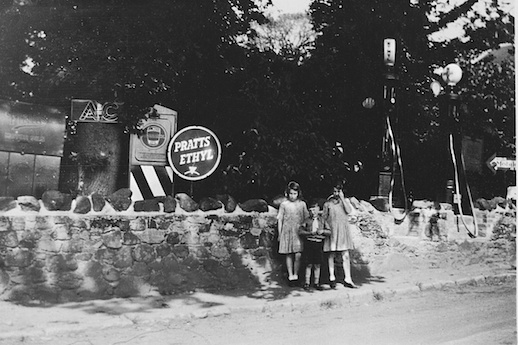 My dad with his older sisters Ada (left) and Ethel, early 1930s
My dad with his older sisters Ada (left) and Ethel, early 1930s
In the early 1950s the smithy also expanded with the addition of a large workshop that still abuts the old stone building, with a door linking the two and a set of double doors to the rear. Clad in sheets of corrugated iron over a timber frame, the workshop boasted a lathe, a grinding machine, a machine for creating screw threads, an automatic hacksaw, a drill and an arc welder, all powered by electricity via a seemingly rickety system of Heath Robinson-like belts, shafts and wheels. (A note written in pencil on the timber frame of the building reveals this modernisation wasn’t totally straightforward – the welder was bought on 14 April 1953 but the three-phase electricity to power wasn’t installed until 31 December, nine months later.) Nevertheless, for a few decades this was a place of serious industry and it was often filled with bent trailers, broken balers and other farm machinery brought by local farmers for my dad to fix through a combination of his ingenuity, welding and hammering. When all the heavy machinery was up and running the building was a cauldron of noise and shook to its brick foundations.
I remember being put to work there as a teenager during school holidays and on occasional Saturdays. I’d be given tasks such as manning the hacksaw, setting the blade to work through lengths of metal that my dad had marked up. Sometimes I’d be told to drill holes in metal plates; other times it was my job to paint finished pieces with Dad’s seemingly never-ending supply of black paint. I was too young to know what I was actually doing or helping to make, but the clatter and racket of the machinery was so astonishingly loud it was almost otherworldly, an exciting taste of the adult world, as grown-up and dangerous as the spirals of deadly-sharp swarf that littered the floor.
Like the smithy next door the workshop has faded with age. The big pieces of machinery have gone now but the welding machine is still there, once a dark olive green but now slowly succumbing to rust. The welding torch, its handle bundled in yards of insulating tape, and the welding mask sit on top of it as if they were left there yesterday, but the layers of gathering dust show that’s an illusion.
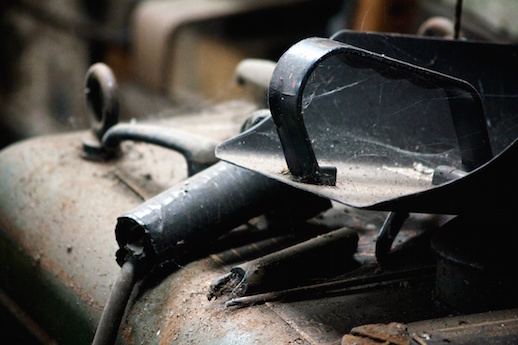 The welding machine, torch and mask 2015
The welding machine, torch and mask 2015
On shelves running round the building sit a mix of curiosities. Small piles of taps and dies; ancient oil tins; welding rods; the winding key of a black clock that once sat on the shelf but which is now gone; a lamp that hung above the lathe, still plugged in and poised. There are cutting tools for the lathe; an oxyacetylene torch in a box raddled with age; a small jug with an oriental design that looks completely out of place but which is firmly rooted in a mesh of cobwebs. From a nail hangs a phenomenally detailed chart – ‘Castrol lubrication index, recommended grades for motor cars and light vans 1952 to 1968’ – that’s now torn in a couple of places and folding in on itself with age. If you ever find that you need a quarter-inch or half-inch cotter pin this is the place to come, there are boxes and boxes of them. A world of tools hangs from nails all around, offcuts of metal clutter the floor, lengths of steel dull with rust lean against a wall. On the door through to the smithy is the trademark Hewit paint job created by cleaning paintbrushes, this one an attractive abstract of red and white on the blackened wood.
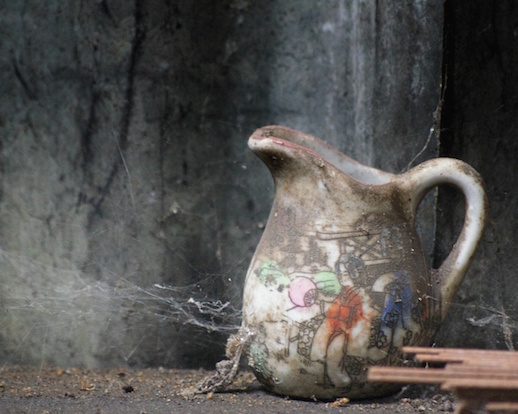 A touch of the Orient in the workshop
A touch of the Orient in the workshop
This is John’s domain now. He didn’t take over the family business but he did inherit the engineering gene, the ability to make and mend. The work bench is covered in his tools now, a radio, cordless drills, safety goggles. An old Land Rover sits in the middle of the floor, a work in progress that he’ll sell when he’s repaired and refurbished it. His next project, a sit-on lawnmower, waits for his attention.
All the petrol pumps and oil cabinets have been taken away. Back in the day some regular customers were trusted to pump their own petrol and put it on account, but most people would park in the road next to the pump and then come to the smithy to find my dad or, if he was busy, I’d often be the one who had to pump the petrol by hand, a half gallon at a time, careful to drain the last drop from the long rubber hose and then take the money and put it into the battered black cash box that was kept in a kitchen cupboard beside the tins of Mum’s home baking. Sometimes there would be a knock at the door late at night from a driver desperate for petrol who’d found the petrol stations in Kelso closed and had been told ‘Try Bob Hewit in Heiton’ – Dad would always oblige. Security was tight. The pump would be locked up at night and at bedtime Dad would tuck the cash box under his arm and take it upstairs to slip it under his bed for safekeeping.
Dad worked hard all his life but he was never a rich man. His needs were few – his family, his garden (especially his carefully tended sweet peas) and his pipe. He wasn’t one for frippery. Even so, and despite all the hard work and long hours he’d put in, the business was slowly dying, just like many rural trades at the end of the 20th century. Traditionally, one of Dad’s busiest times was in the spring when he’d be occupied for weeks on end making or repairing harrow teeth by the hundreds and setting them into the harrow frames. Then, slowly, surely, the farmers stopped coming to him or went elsewhere for their repairs having invested in better and newer equipment. Other regular work melted away too, and eventually profit turned to loss. My mum would pay business cheques into the bank and towards the end the money she took out for housekeeping was more than Dad’s meagre earnings. It made no sense to carry on; at the age of 58 Dad was unemployed.
Dad eventually found a new job with a local garage, delivering spare parts all around Roxburghshire and beyond. He liked his new job and it suited him – driving around in his van all day, puffing away at his pipe, enjoying the novelty of meeting new people, enjoying his new lease of life. Ironically he probably earned more in his seven years driving a van until he retired than he had in twice that time at the smithy.
Old skills die hard though and Dad continued to shoe horses for a few long-standing customers until he was 68, still firing up the forge to make the shoes by hand as he’d always done. He shoed his last horse in 1996 and to mark the occasion John, Sandra and I bought him a silver quaich, which pleased him. It felt like a momentous milestone at the time, but like most big occasions the true significance isn’t appreciated until much later. Now I wonder afresh how Dad felt and what he thought about when he packed away his leather apron and his tools, his hammers, rasps, pincers and hoof knife, for the last time. Perhaps he reflected on his 53 years as a farrier and blacksmith and thought about his father and grandfather before him, weighing history. Perhaps he sighed with regret, perhaps relief. Knowing my dad, he was probably quietly proud but didn’t want to make a fuss.
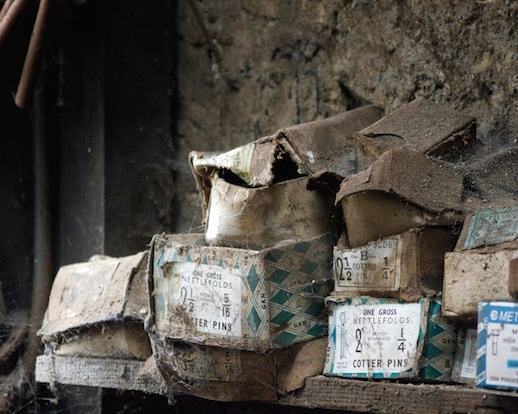 Cotter pins, all sizes
Cotter pins, all sizes
View the previous Last Blacksmith posts here